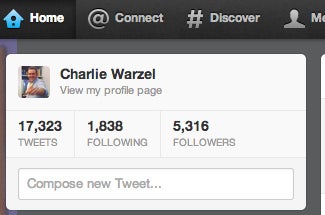
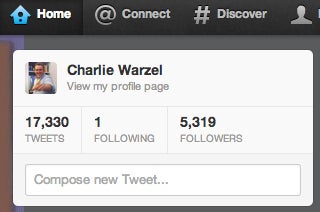
Yesterday I did what for me qualifies as the unthinkable: I nuked my Twitter feed.
For the better part of five years, Twitter has been the dominant internet service in my life. It's easily the most used app on my phone and probably responsible for 75% of my idle swiping and tapping. For work, it is absolutely essential both as a broadcasting platform and as a means to figure out what the hell is going on in the areas I cover. It's the first thing I look at in the morning and often the last thing I check at night. I've been meticulously curating my Twitter feed for as long as I've worked in media. And yesterday, I systematically destroyed it all. Here's why.
I've been involved on three distinct beats: politics, media, and tech. With each beat I added a different caste of follows. In some cases I went overboard, following obscure, entirely nonessential persons, brands, celebrities, news organizations, and a generous handful of very stupid parody accounts. I'd gone as high as 2,000 follows, but as of yesterday the number was at 1,838 accounts. It was entirely too many. Going into 2014, my feed had become intolerable. During big news days, my feed would move quicker than I could read it. Lately, Tweetdeck's internet client began to fail me, lagging under the weight of nearly 2,000 constantly chattering voices. The noise had overpowered the signal. I found myself wondering, at times, if the signal still existed at all.
I'd joked a lot in the past about a "Great Reset," but my envy for those with more manageable accounts — and perhaps more discipline — was real. I was nervous to knock down something I'd spent so long building, but gradually realized I had no choice. Twitter was too much, even when nothing was happening.
So I began:
There's no reliable way to bulk unfollow, and besides, I wanted to savor the experience. The web client is the easiest way to go about this (on Twitter's mobile every unfollow asks for confirmation) but it's still a pain. The "unfollow" button isn't very responsive to clicks and sometimes it took three or four tries to go through. This led to a lot of quick unfollow/refollow clicks, which would send a "Charlie Warzel is now following you on Twitter!" emails to friends, co-workers, family. It's a process that seems intentionally designed to be frustrating and it's a pretty good deterrent for bulk unfollows. Oh, and it took nearly three and a half hours.
The most surprising thing about the process is how genuinely hard it was for me. Scrolling through my following list was like unpacking the contents of a time capsule, or flipping through an old high school yearbook, before throwing it away. I was surprised I could remember the stories behind so many of the accounts I followed, as many of them corresponded to different moments in my career or different news events. Political consultants from my time in D.C. Police scanners and random Boston residents from last year's bomber manhunt. And some rather embarrassing novelty accounts.
A few examples:


Severing these connections felt a bit like I was casting aside the corresponding memories as well. And, though it sounds dumb, there were even a few poignant moments. People I'd followed (some of which I knew) who were now deceased. I unfollowed them, knowing full well that I'd never follow them again — an unexpected last good-bye of sorts. Also, I had to unfollow my parents, which just felt kind of wrong. I then watched with a pit in my stomach as brands and news organizations slowly took over my feed.
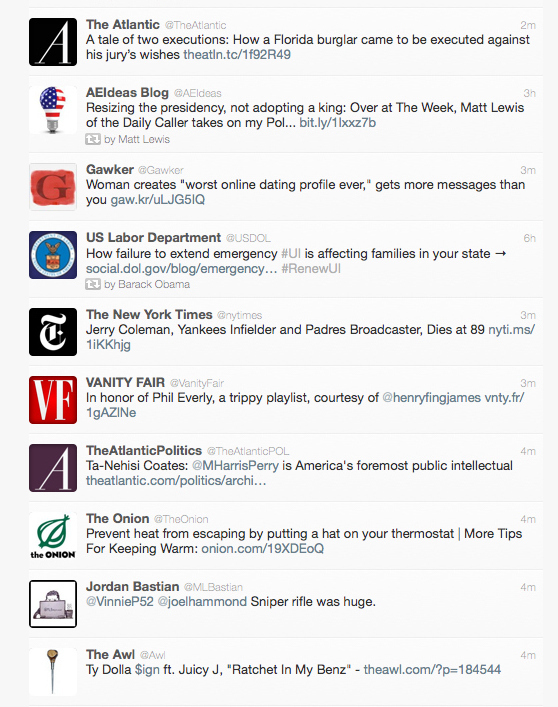
And finally, at 4:48 p.m., it happened.

"You aren't following anyone yet." Yet! That's not quite how I'd put it, but way to look forward, Twitter.
But then... a lot of weird stuff started to happen...

Once the purge was complete, Twitter immediately started treating me like a new user, placing a large "suggested follow" widget at the top of my now-barren feed. On mobile, Twitter tried to coax me to "follow 6 more accounts." Even after five years on the service, offering up innumerable data points, Twitter seemed to know nothing about me. I asked it to forget, and as far as I can tell, it did.
Instead of past follows, the recommendation widget suggested the usual coterie of bland celebrities and brand accounts. A reset in the truest sense.
Second, even though I'd successfully unfollowed everyone, Twitter refused to clear my feed completely. It continued to feed me from tweets, without explanation, from one of my former editors, as well as Business Insider's Henry Blodget. This is still happening, to my knowledge. It seems, in my case, there is no escaping Henry Blodget.
@nickrizzo @cwarzel shows me the only Twitter user you are following is @Reince.

Brian Ries
@moneyries
@nickrizzo @cwarzel shows me the only Twitter user you are following is @Reince.
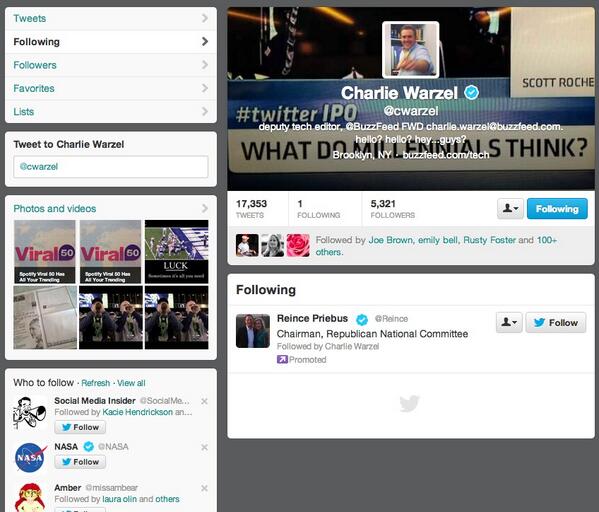
Since I wasn't following anyone, Twitter used the open real estate to house some promoted follows, like Reince Priebus. To anyone who bothered to look at my account, it looked like the Republic National Committee had sponsored my feed.
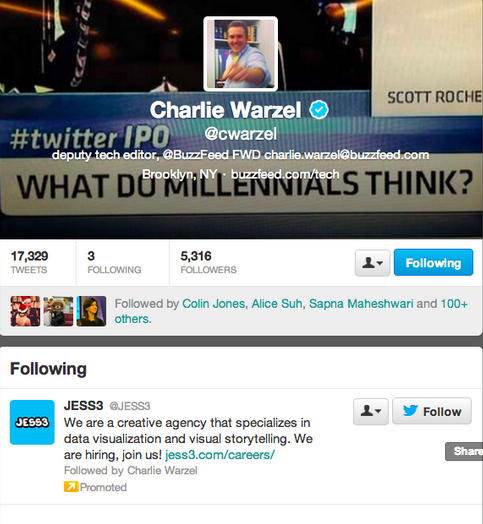
My stream, aside from the occasional Blodget tweet, was comprised entirely of my own material. This made the occasional sponsored tweet stand out even more than normal. Its subject matter was eerily prescient:

But the strangest thing of all was the feeling of isolation. My once-kinetic feed was now nearly static, but I knew that Twitter — my old Twitter, your Twitter, Twitter at large — was still happening around me. Last night, watching the BCS National Championship game — an event I'd usually follow along with on Twitter — I sent off a few errant tweets, without the benefit of context. I fired off my observations into the ether, unsure of their place in the rhythm and relevance of the conversation. It was like going deaf in the middle of a dinner party.
This Twitter experience — all broadcasting and zero listening — is shared with two other groups: robots and celebrities. I am neither, so Twitter became, for my purposes, rather worthless. It was only one night, but the silence was enjoyable. One or two texts aside, I hardly picked up my phone. I read more than I usually do. It was a brief forced respite from the minutiae of the nightly Twitter outrages and micro news cycles.
I was also rather lost. Before nuking my account, I was keenly aware of my tether to Twitter, but stepping away revealed just how much I depend on my feed. In the past 20 hours I've been disconnected but also disoriented. Not only do I not feel like I know what's going on in the areas I cover and care about, but I also don't know where to look to find it. I ambled about the internet for a while this morning, typing in URLs and following links. At one point I ended up at Yahoo's homepage earnestly seeking news. The only tweets I saw were those that were emailed or messaged directly to me. It might sound overdramatic, but it's an isolation that feels, for better or worse, very real.
That said, I can't shake the feeling that anyone who relies on Twitter every day should try this. I'm slightly unnerved by the experience so far, but excited to start over. I nuked my feed, and I'm fine. Now it's time to rebuild.
